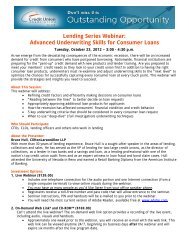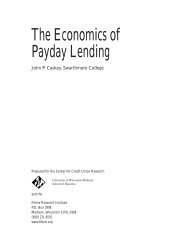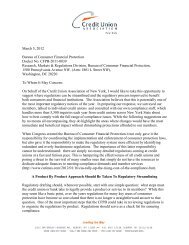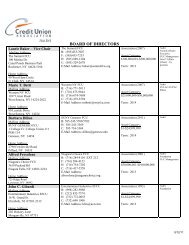Published by the Credit Union Association of New York
Published by the Credit Union Association of New York
Published by the Credit Union Association of New York
Create successful ePaper yourself
Turn your PDF publications into a flip-book with our unique Google optimized e-Paper software.
featurestory<br />
In <strong>New</strong> <strong>York</strong>, auto lending opportunities<br />
continue to grow<br />
By Ray Birch, Guest Contributor<br />
NEW CAR SALES ARE COMING BACK, BUT CREDIT UNION AUTO<br />
lending is not keeping pace with <strong>the</strong> increase, according to<br />
national statistics.<br />
However, that’s not <strong>the</strong> case in <strong>the</strong> Empire State.<br />
<strong>New</strong> <strong>York</strong> credit unions (2.41 percent) easily outpaced<br />
<strong>the</strong> national credit union auto loan growth average (.32<br />
percent) in 2011, and this year CU Direct Corp. reports that<br />
credit union auto loan portfolios in <strong>New</strong> <strong>York</strong> are on track<br />
with <strong>the</strong> rise in new car sales.<br />
“Nationally, auto sales continue to increase. I have seen<br />
reports around 20 percent year-over-year growth,” says Bob<br />
Nealon, regional VP <strong>of</strong> CU Direct Corp. “<strong>Credit</strong> unions in<br />
<strong>New</strong> <strong>York</strong> that are using CU Direct are reporting increases<br />
in auto loan volume relative to <strong>the</strong><br />
pick-up in new car sales.”<br />
The opportunity is <strong>the</strong>re, and<br />
even more will come, notes Bill<br />
Hampel, CUNA’s chief economist<br />
and SVP <strong>of</strong> research and policy<br />
analysis. He projects that annual new<br />
car sales should reach 14.5 to 15<br />
million units in <strong>the</strong> next two years<br />
and 16 million shortly afterward—<br />
which would bring new car sales<br />
back to almost pre-recession levels.<br />
What’s heating things up is pent-up demand, he explains,<br />
noting that <strong>the</strong> average age <strong>of</strong> cars on <strong>the</strong> road is at a record<br />
level: 10.5 to 11 years.<br />
“There are people now who have changed <strong>the</strong>ir carbuying<br />
habits and realize <strong>the</strong>y don’t have to buy a new car<br />
every three years,” says Hampel. “But <strong>the</strong>re is a larger<br />
segment that is tired <strong>of</strong> hanging onto that old car and dealing<br />
with its problems. More consumers are feeling sufficiently<br />
confident about <strong>the</strong>ir economic prospects and job security<br />
that <strong>the</strong>y will go out and buy. <strong>New</strong> car sales should be pretty<br />
robust <strong>the</strong> next few years.”<br />
Manufacturer incentives stealing new financing<br />
Hampel also notes that, for some reason, credit unions<br />
Empire State<br />
credit unions are<br />
competing effectively.<br />
nationally are not getting <strong>the</strong>ir share <strong>of</strong> this growth. He<br />
surmises that manufacturer incentives could be a big reason—<br />
and now that U.S. automakers have retooled and improved<br />
<strong>the</strong>ir manufacturing to run production lines in accordance<br />
with consumer demand, <strong>the</strong>y will begin to remove <strong>the</strong><br />
widespread incentives in <strong>the</strong> coming years.<br />
Nealon believes one reason <strong>New</strong> <strong>York</strong> credit unions are<br />
doing much better than <strong>the</strong> national average is because <strong>the</strong>y<br />
are simply working harder. “They realize <strong>the</strong> auto loan is <strong>the</strong><br />
best option for <strong>the</strong>ir portfolios now, in return and risk. There<br />
is a lot <strong>of</strong> attention on interest rate risk, and auto loans, as we<br />
know, turn over quickly,” he says.<br />
Empire State credit unions are competing effectively both<br />
on <strong>the</strong> direct and indirect sides, adds<br />
Nealon. Indirect channels are faring best,<br />
due to lenders building strong programs<br />
based on excellent dealer relationships.<br />
<strong>New</strong> member-focused efforts are<br />
lifting <strong>the</strong> direct channel, as well. “We<br />
are seeing more credit unions in <strong>New</strong><br />
<strong>York</strong> do more with preapprovals and<br />
finding ways to engage <strong>the</strong> member<br />
early on in <strong>the</strong> buying process so <strong>the</strong>y<br />
don’t lose <strong>the</strong>m later,” notes Nealon.<br />
Some <strong>of</strong> those steps are car-buying and<br />
research tools on credit union websites, as well as automated<br />
programs that make it simple for dealers to close a loan with<br />
<strong>the</strong> credit union member.<br />
The direct market is still very tough, according to three<br />
<strong>New</strong> <strong>York</strong> credit unions—Nassau Educators FCU (NEFCU),<br />
Hudson Valley FCU (HVFCU) and Olean Area FCU—that<br />
are all growing loans well through indirect channels.<br />
NEFCU placed 6th in <strong>the</strong> nation for 12-month auto loan<br />
growth as <strong>of</strong> June 2011, according to Callahan’s 2012 <strong>Credit</strong><br />
<strong>Union</strong> Directory. Year over year, <strong>the</strong> credit union is up $96<br />
million in its auto loan portfolio, a 44 percent increase over<br />
2011. “We have been able to find pockets <strong>of</strong> business and<br />
make <strong>the</strong>m grow,” says Chuck Price, NEFCU’s AVP <strong>of</strong> lending.<br />
4 SEPTEMBER 2012 Connection






